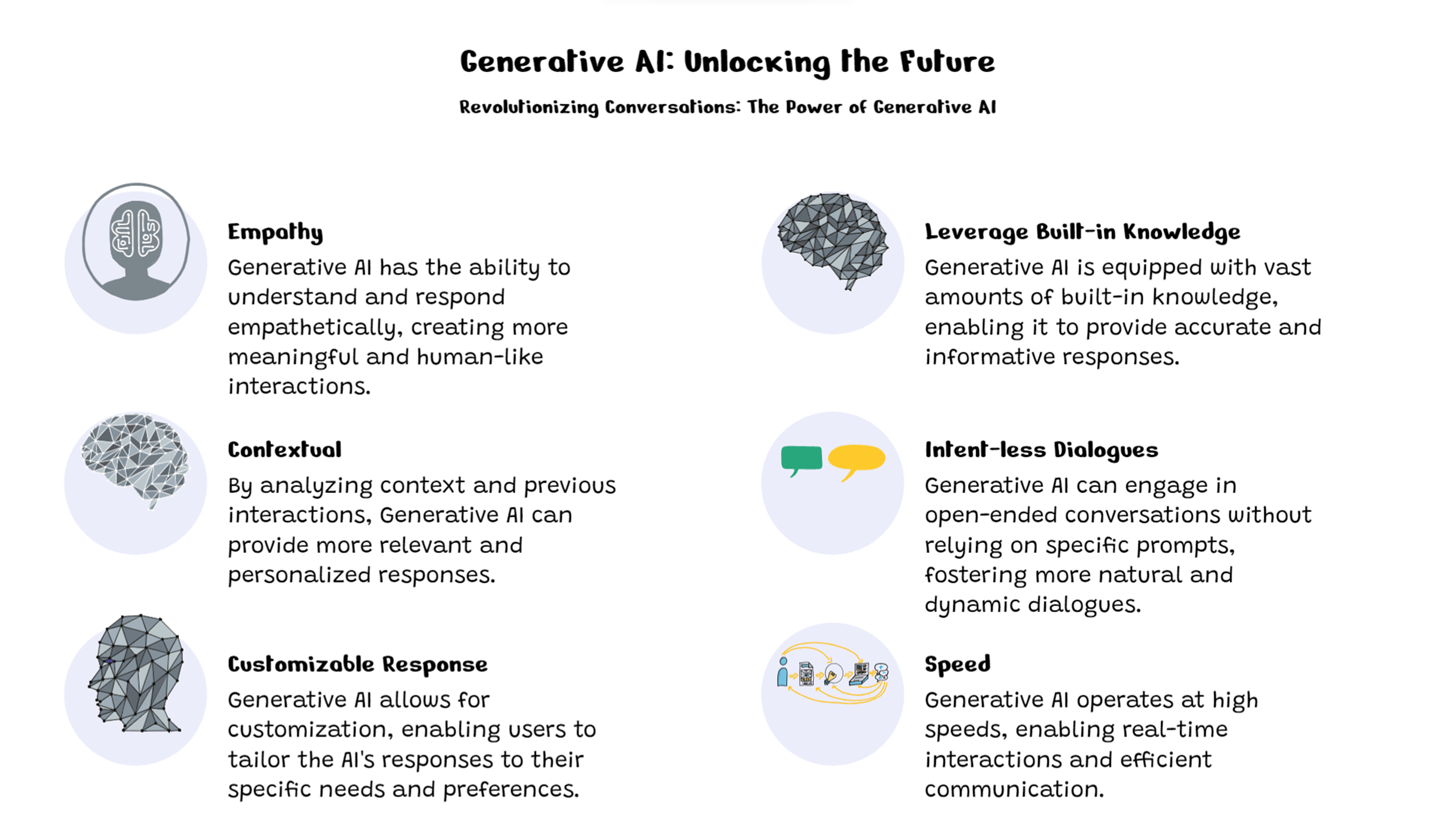Table of Contents
Since the launch of ChatGPT by OpenAI on November 30, 2022, the Generative AI field has witnessed unprecedented levels of interest across industries, and it is becoming an increasingly popular tool for businesses to engage customers in a new way. While Generative AI can be used to transform the customer experience, it is too overwhelming for businesses to keep-up with the pace of development of these large language models (LLMs). In this blog post, we’ll explore some of the top use cases of Generative AI in the customer service function.
McKinsey’s 2022 State of Customer Care Survey has found that customer care is a strategic focus for companies. Survey respondents said that their top three priorities over the next 12 to 24 months will be retaining and developing the best people, driving a simplified customer experience (CX) while reducing call volumes and costs, and building their digital care and advanced analytics ecosystems. It is not surprising given the result of the last year survey of 2,000 Americans conducted by OnePoll on behalf of Twilio Flex. According to the survey results, 62% of respondents have stopped using a company or service specifically because of a bad customer support experience. In addition to that, 52% of people surveyed want to be able to solve their issue without speaking on the phone to a live person through text, online live chat, self-service online, etc. Given the current state of customer experience, it is imperative for businesses to start integrating Generative AI-powered chatbots or virtual assistants into customer service. Let’s explore why.
Future of CX with Generative AI
Generative AI-powered chatbots or virtual assistants can understand and respond to customer inquiries more accurately as compared to traditional bots and in some cases to even human agents. This is because of the following six characteristics of Generative AI as shown in the picture below and explained thereafter.

- Empathy: Chatbots powered by Generative AI have the ability to empathize with customers and establish 1-on-1 connection during conversations thereby elevating customer experience. For example, you can expect Gen AI chatbots to apologize, thank you or even congratulate you if it’s your birthday, while simple chatbots are programmed with limited set of responses.
- Contextual: Gen AI chatbots are capable of correctly interpreting the reason behind a statement during a customer conversation thereby remaining contextual. For example, if you’re chatting with a Retail Assistant powered by Gen AI about your order delivery date and you suddenly remark, “Oh bad, I’m attending a wedding that day”, the Retail Assistant would understand this remark that seem out of scope but makes perfect sense in the context. In this example, Gen AI understands that you won’t be available at home to take the delivery and would propose alternatives.
- Customizable Responses: Gen AI chatbots support advanced AI-powered conversations that are customized to the individual’s context and preferences thereby enhancing the user experience. You can instruct Generative AI-powered chatbots how to respond to a particular set of users – for example, AI can be instructed to use emojis and respond as if chatting with a college-aged female.
- Built-in Knowledge: Gen AI chatbots or virtual assistants leverages all enterprise knowledge and data to provide agents with the most accurate information possible on real-time basis. It has the ability to self-learn all enterprise knowledge and continuously improves based on agent or customer feedback. This helps in reducing dependency on human agents as Gen AI chatbots can handle customer interactions of varied complexity without the need for human intervention.
- Intent-less Dialogues: Gen AI need very little training data to offer intent-less dialogues. While traditional chatbots have to be programmed with a lot of intents and utterances, Gen AI can handle nuanced dialogues that intents cannot and is fully controllable with business logic.
- Speed: Since Gen AI requires little training data and offers intent-less dialogues, it can also help streamline the development and deployment of enterprise-level conversational bots, resulting in increased efficiency and cost savings.
Generative AI Use Cases in Customer Service
While business rush to test waters with Generative AI, it is imperative to understand the technology’s potential in delivering value to different stakeholders in the customer experience function. We used three lenses to identify potential use cases of Generative AI with its current capabilities as shown in the picture below.

- Reducing Customer Efforts: Currently, customer have to make huge efforts to get their queries resolved. OnePoll survey revealed that two-thirds (65%) of those surveyed said it “doesn’t feel worth it” to get an issue resolved, due to the time and effort it takes. 42% of respondent complained having to contact a company multiple times to get an issue resolved, while 45% complained having to repeat details of the issue to a new representative after being transferred or being disconnected. Generative AI can be used to reduce a lot of these customer complaints and efforts in following ways
- Advanced Conversational AI: While conversational AI had been in existence for a while, advanced Generative AI-powered chatbots or virtual assistants are coming into play to engage with customers in real-time wherever those text-based customer interactions occur — for instance, on websites, SMS, Mobile Apps, Social Media, etc. Generative AI can also enhance conversational AI’s multilingual capabilities thereby increasing the chatbot’s target user base by allowing it to communicate with customers in multiple languages. Several Conversational AI Platforms such as Amelia and Kore.ai are integrating LLMs within their platforms. SupportGPT of Forethought, Rasa’s Generative AI, Cognigy.AI and Autonom8 are interesting platforms to watch-out.
- Voice AI or Voice RPA: Generative AI has the capability to create human-sounding voice AI solutions that can place or answer phone calls on behalf of human users to complete routine tasks without the need of any human intervention. Replicant is one promising startup applying voice AI to automate contact center agent activity. Other noteworthy startups include AI Rudder, Resemble AI and Infinitus (offers voice AI technology for healthcare and has termed it as “VoiceRPA”).
- Conversational Analytics: Generative AI can be leveraged to analyse customer interactions not only to offer value added services to customers (for example, product comparisons, product recommendations, etc.) but also offer conversational coaching and analytics for human call center agents. Cresta focuses on providing personalized coaching to contact center agents in real-time, while Observe.AI have been building large language models to understand and analyse customer conversations.
- Reducing Agent Efforts: Most of the time customer service agents are not equipped with the right information needed to address a customer issue, resulting in increased agent effort and poor customer experience. According to the OnePoll survey results, 54% of those surveyed wished that the representative has access to relevant information to their issue, so they don’t have to repeat themselves when transferred. Generative AI not only can help agents by providing the right information needed at the right time but also help free up their time by automating a few of their activities. Here are a few examples.
- Agent Assist: Generative AI has the ability to get all the relevant customer information from the CRM, provide sentiment indication, use speech-to-text transcription to search for articles & information in real-time, and produce best answer to assist an agent. Cognigy’s Generative AI offerings for Contact Centers include next generation Agent Assist Solution. Likewise, AgentGPT of Level.AI auto-generate accurate answers to customer questions.
- Post-Contact / After Call Work Processing: LLMs can be used to automate post-contact processing tasks such as ticket tagging, contact summarizing, sending follow-ups, etc. Talkdesk launched call summarization, which integrates GPT services into its NLP systems, while other CCaaS vendors – including NICE and Five9 – have also launched similar solutions.
- Content Generation & Moderation: Generative AI can also be used to help organizations create content or applying NLP to moderate user-generated content on any platform ranging from gaming companies to dating apps. While there are many companies offering Generative AI-based content creation solutions, Spectrum Labs is one promising startup applying AI to combat online toxicity. Another interesting player in this category is Logically that focuses on misinformation and disinformation.
- Improving Enterprise-wide Experience: While reducing customer and agent efforts are the two key drivers for adoption of Generative AI, it can be used across the enterprise to improve employee experience which in turn will have a bearing on customer experience. Some examples are as follows
- Auto Quality Assurance: Generative AI can be used to score agents interactions fast and accurately, thereby creating real-time reports and feedback to improve agent performance. EvaluAgent, for example, integrated ChatGPT and launched SmartScore, that can evaluate any conversation across any channel in less than 10 seconds, build custom scorecards and automatically send evaluations to assessors’ inboxes.
- Advanced Knowledge Management: Generative AI can auto-generate knowledge articles from past case notes and store those within the CRM for agents to scour through these articles to create personalized customer responses on live chat. Salesforce launched Einstein GPT, the generative AI for CRM allowing businesses to auto-generate knowledge articles for review. Inbenta, a niche player, also offers knowledge management AI.
- Automated Employee Helpdesk: Conversational AI platforms can automatically field and resolve many of these employee support requests, reducing the need for human intervention. Moveworks, Espressive and Rezolve.ai offer AI-driven product offerings to resolve helpdesk tickets with reduced intervention.
These are just a few examples of the many use cases for Generative AI in customer service. There are immense possibilities, and as the technology evolves, customer experience evangelists across businesses will find many innovative ways to incorporate it into their CX strategies. However, leveraging LLMs for customer experience requires careful consideration of multiple factors such as choosing the right LLM for the specific use case and domain, integrating LLMs with enterprise data sources and systems, ensuring the quality, reliability, and ethics of LLM outputs, and unlocking the ROI of enterprise LLM bots.
At InGROUP Consulting, we are passionate about helping businesses transform their customer experience by leveraging Generative AI capabilities. If you are interested in learning more about these use cases and how you can use Generative AI to transform experience for your customers, we would love to talk. Write to us at info@ingroupconsult.com for more information.
Stay tuned for our next week’s blog on “Developing Pipeline of GenAI Projects in Customer Service”.
Images created using Drawify.

